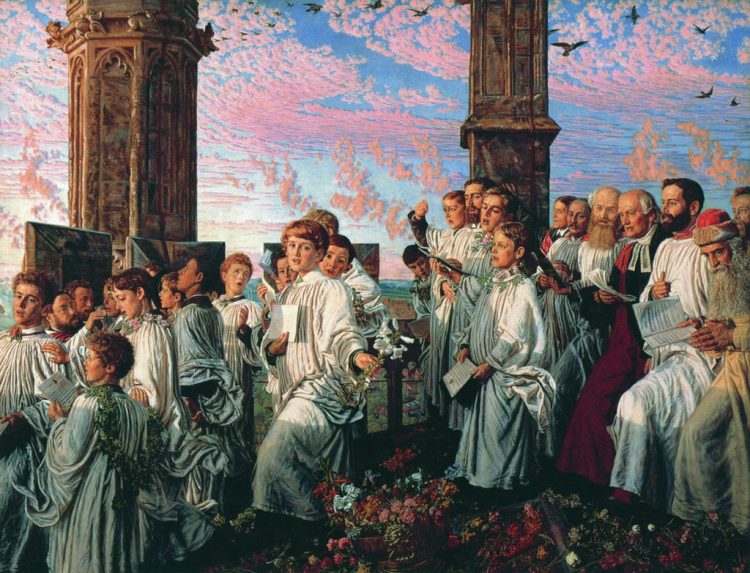A May Morning Portrait
1 May 2020|
- Library, Arts & Archives

On one day in any given year (other than this), tens of thousands flock to the roads and gardens surrounding Magdalen College, Oxford, at six o’clock in the morning to hear the choir sing. From forty metres in the sky, their melody peals out what one former Magdalen President called ‘a monkish Latin Hymn’. On any other day, the choir could be heard at the more convenient time of six o’clock in the evening ̶̶̶̶̶̶̶ and in the inviting, candlelit chapel with its warm and beautiful acoustic; but there is something about the mystery and rarity of the May Morning celebrations that compels people to experience for themselves a tradition which, it seems, stretches back half a millennium.
For three years, I was one of those who sleepily and silently climbed the steeply spiralling steps, negotiated the final ladder and emerged into the suddenly bracing rooftop of the great bell tower of Magdalen College. From there, I looked down with my fellow choir members over the huge crowds waiting below. Some had been up all night; others had awoken at a time when they were thoroughly unaccustomed to being awake. But on the top of Oxford’s tallest medieval tower, it is no longer possible to feel sleepy. Even if the air at ground level seems calm, the wind moves differently at the top, and since the sun has had no chance to exert its warmth, heat generated by the climb of 172 steps is quickly lost.
Those viewing from afar, though, are unconcerned by the practical difficulties of singing whilst balancing on a sloping roof or caught in the circling wind. For them, the sound of choral strains scattered across a beautiful sunrise and the promise of a warming beverage or lavish breakfast to follow is well worth the early rise.
The romance of the occasion is perfectly evoked by William Holman Hunt (1827-1910) in his glorious painting ‘May Morning on Magdalen Tower’, which he created following his own May Morning experience at the top of the tower in 1888, extant in two versions both painted by Hunt.
Much though this belongs to Magdalen’s history, there is, buried in the detail of Holman Hunt’s masterpiece, a reminder of a significant piece of St Edmund Hall’s musical history too. While in the left hand corner of the picture, the bearded figure of the choir’s conductor at the time, John Varley Roberts, can be seen giving direction to his singers, two of his predecessors are also included in the painting: Sir John Stainer (organist at Magdalen 1860-1872) and Stainer’s successor, Sir Walter Parratt.
Stainer, the sixth figure in from the right, was Professor of Music at Oxford ̶̶̶̶̶̶̶ at least by the time the painting was finished ̶̶̶̶̶̶̶ but had come to Oxford first as a very young man, being appointed to the post of organist at Magdalen even before turning twenty. The post was offered on a trial basis and the intention was that Stainer would also read for an Arts degree at Oxford. The President of Magdalen, however, recommended that Stainer should enter some other college as an undergraduate since there were no available places on the Commoners’ list at Magdalen and in any case the expenses were likely to be too great. He suggested St Edmund Hall as a suitable place. So it was that Stainer came into residence at St Edmund Hall in 1861 and remained as a member of the Hall throughout his undergraduate study, obtaining his BA in 1864.
Stainer’s early brilliance that had attracted the attention of Magdalen College remained with him for the rest of his professional life. Through his musical skills and infectious personality, he brought cathedral music in England to new heights, especially at St Paul’s Cathedral where as organist he transformed its choral singing. Moreover, he was a remarkable scholar and prepared editions of plainchant and medieval music long before any widespread interest in the repertory existed. His most enduring composition, ‘The Crucifixion’ had been premiered just the year before Holman Hunt ascended Magdalen tower in 1888 but some of his other pieces that have remained in the repertoire were written when Stainer was a young man: we know of at least one work which he wrote whilst an undergraduate at the Hall and his arresting anthem ‘I saw the Lord’ was composed while still a teenager.
Stainer, as a brilliant undergraduate of St Edmund Hall, will have climbed those steps several times to lead the city’s and university’s festive welcome of spring at Magdalen, where he served as organist. Perhaps he, like those of us who followed on later, was rewarded on his descent from the tower with a fine breakfast laid on in college rooms.
Category: Library, Arts & Archives